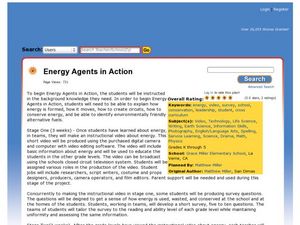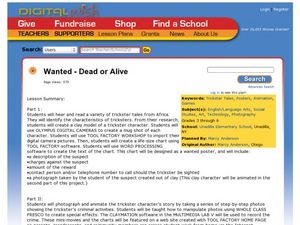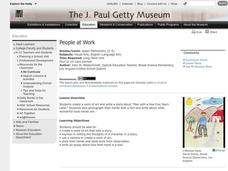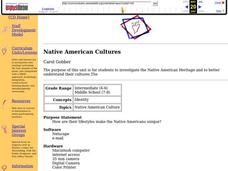Curated OER
A Gesture Is Worth a Thousand Words
Students share observations on the nuances of meaning in face to face and online interactions with others. After reading an article, they identify the causes and effects of internet flaming. They create their own comic strips...
Curated OER
Communicating through Engineering Information Technology
Students analyze prior labs by keeping a lab notebook. They share their lab notebook by electronically sending it to their classmates. Students demonstrate evaluation of other lab notebooks within the same classroom and those from other...
Curated OER
BEGINNER LEVEL LESSON PLAN ANTICIPATORY SET
Students are be able to analyze primary sources for evidence of American entrepreneurship during the early 20th century. They identify the attributes that helped George Eastman succeed as an entrepreneur and consider the role advertising...
Curated OER
Checkmate
Students start identifying the cause and effect relationships in games of Chess. Using the internet, they research the history of the game and how the roles for each of the pieces. They develop a skit based on the roles and...
Curated OER
Force and Motion Flip Books
Fourth graders identify six simple machines in real world examples, distinguish between the three different types of levers and explain Newton's three laws of motion. They create a multimedia presentation over the information they've...
Curated OER
Create a Weather Newscast
Fourth graders explore and study basic weather terms, strengthen research skill on the web and create a weather newscast. They choose a weather site on the web, copy weather maps and create a videotape based on a written script to...
Curated OER
Proportional Reasoning
In this proportional reasoning activity, students use proportions to solve discount and sale problems. This two-page activity contains 4 multi-step problems.
Curated OER
Power Functions: A Question of Magnitude
For this power functions worksheet, students read about determining the brightness of stars using a magnitude scale. Students solve 4 problems including finding the magnitude differences of stars and determining equivalent magnitudes.
Curated OER
Energy Agents in Action
Young scholars share information about energy use and conservation. For this energy use lesson, students work as a production team to make an instructional video about basic energy information. They develop a short survey about energy...
Curated OER
What's the Matter?
Students explore matter. In this matter and technology lesson, students locate examples of solids, liquids, and gases inside and outside the classroom, and record their findings in a graphic organizer. Students listen to the...
Curated OER
Wanted- Dead or Alive
Students identify the characteristics of trickster tales. In this literary genres lesson, students read trickster tales from Africa and create a clay model of a trickster character. Students design a "wanted" poster with a...
Curated OER
American History Digital Movie
Fifth graders create a video. For this historical presentation, 5th graders watch a video clip of a dramatization of a historical event in American History. Students discuss how this video was put together. Students divide into small...
Curated OER
Cultures and Cuisines WebQuest
Students create and present a powerpoint presentation. In this cultures and cuisines research lesson, students select a country, interview someone from that country and visit a restaurant from that country. Students complete...
Curated OER
GPS Ecosystem (Ecotone) Scavenger Hunt
Students describe the characteristics of an ecotone. In this ecotone instructional activity, students pick out their area and describe the visual appearance, conditions, ecosystem, biodiversity, predators, prey, and trees in their...
Curated OER
Images of Children in Dorthea Lange's Photographs
Students research the photographs of Dorthea Lange. In this visual art lesson, students look at photographs of children taken by Lange and answer several questions. They write or tell stories to explain what they think is occurring in...
Curated OER
Best Part of Me
Learners find the best part of their body. In this positive self-concept lesson, students listen to the story The Best Part of Me. They come up with their best feature and write a poem about it.
Curated OER
Camouflage: A Study of Stealth and Survival
Students study insect camouflage. In this organisms lesson, students design and create their own 3D insect models to blend into a habitat. Students write a paragraph about the camouflage their insect has and explain how their insect is...
Curated OER
Migrant Workers Through the Lens of Dorothea Lange
Students explore the lives of migrant workers during the Great Depression. In this Great Depression lesson, students examine photographs and song lyrics to gain an understanding of the conditions for people living in the era. Students...
Curated OER
Computer Words
Here is a set of cards explaining the meanings of a variety of different parts of a computer. While not exactly a lesson per se, these cards could be printed out and used quite easily in a formatted lesson. In this time of computers,...
Curated OER
People at Work
Students create a work of art and write a story about "Man with a Hoe Five Years Later." students also photograph their hands with a tool and write about what wonderful tools hands are.
Curated OER
Native American Cultures
Students investigate the Native American Heritage and explore their customs cultures. They discover characteristics of the Native Americans through the study of their art, artifacts, stories and symbols.
Curated OER
Putting on Beowulf
Students read "Putting on Beowulf" then, in separate groups, choose a segment of Beowulf to perform. They prepare a performance either "live" or on videotape. After listening and watching each performance, Students evaluate each...
Curated OER
Digital Scavenger Hunt
Students participate in a game of scavenger hunt. In this teamwork lesson, students use clues to find hidden objects. Students must work cooperatively to complete each task.
Curated OER
Food Advertising Tricks
Students recognize techniques used to make food look appealing on television and in advertising, and explore the separate elements that compose media messages and products.

























